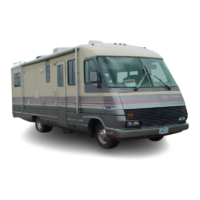ON
THE ROAD
DRIVING AND PARKING
Driving
the
motor home
is
comparable
to
driving your
family
car, once you become accustomed to
the
feel of
the
controls and
to
the
reference points from the dri·
ver's seat relating
to
the
position
of
the
motor
home
in
traffic.
Be
cautious when maneuvering
to
allow for
the
length and width
of
the
vehicle. Always allow extra
room in cornering and when changing lanes. Check the
side mirrors often. Learn
to
use
the
view
of
the
road·
way behind,
as
seen through
the
side mirrors,
as
a refer·
ence
to
help keep s"good road/lane position.
',"
Drive with consideration on
the
highway, observing all
applicable speed and saf,ety regulations.
The
best cruis·
ing speed
for
your
motor
home will vary with road and
weather conditions. Remember
that
the
higher speeds
may result
in
a sharp increase
in
fuel consumption.
Driving
on
winding
or
mountain roads
is
not
difficult if
done
with reasonable care. Observe
proper
vehicle
speeds when ascending
or
descending hills and always
operate in
the
proper
transmission range. Downshift on
hills
to
avoid overheating
or
undue engine loads by us-
ing
tl16
hand control
as
recommended
by
the
Chassis
Operator's Manual. .
Allow for
the
extra height
of
your
coach and avoid
areas having low overhead clearance. Check for
low·
hanging
tree
branches
or
other
obstructions whenever
you drive
or
park. Avoid low roofs when pulling
in
for
service. This may
be
particularly important if you drive
with
the
overhead vents open
or
if
the
coach
is
equipped
with a
roof
air conditioner
or
a roof rack.
When parking parallel, be sure
to
allow
for
poles
or
ob·
structions near
the
curb, as
front
and rear portions
of
the
motor
home swing wider
than
an automobile. When
parking
on
an
incline, it
is
recommended
that
the
front
wheels always be
turned
into
the
curb
in
the
direction
of
roll
to
aid
the
parking brake.
OVERHEATING
The engine and cooling system on
your
vehicle should
be operated and serviced
as
recommended
in
your Chas·
sis Operator's Manual.
WINDSHIELD
DEFROST·
COMFORT CONTROL
During winter months, it
is
important
to
keep the wind·
shield clear and keep
the
passenger
compartment
at
com·
fortable temperatures while on
the
road. This can be
done
by use
of
the
proper
combination of heater and
defroster controls.
Your motor
home
may have separ·
ate
defroster circulating motors and controls
for.
each
side
of
the
winshield (see Figure 2).
Use
these separ·
ately or combined
to
obtain maximum visibility.
5
12-VOL T FUSE REPLACEMENT
If
part
of
your
vehicle electrical system should fail while
on the road, check
the
replacement circuit fuses located
in
the
automotive circuit. These are
automotive-type
fuses available
at
most service stations. Refer
to
the
ELECTRICAL section for information
on
living area
(non·automotive) 12-volt fuses.
CHANGING A TIRE
For tire changing instructions, see Chassis
Operator's
Manual. Your
motor
home
is
equipped
with
premium'
grade truck·type tires. Under normal circumstances
and
with proper tire maintenance, you should receive
thous·
ands of miles
of
trouble·free service. Before
attempting
any repairs
in
the
event you
do
have a flat tire, it should
be noted
that
your
fully·loaded
motor
home
is
very
heavy. As a result, each wheel
lug
nut
is
torqued
to
a
factory recommended setting
of
480
to
500
foot
pounds, making
the
lug nuts extremely difficult
to
reo
move.
In
addition, each tire and wheel weighs
approxi·
mately
90
pounds and
is
difficult
to
handle. It
is
there·
fore advisable
that
you obtain road service wherever
possible and only
attempt
to
change tires
yourself
under
emergency conditions.
WARNING:
LOOSENING THE REAR
LUG
BOLTS MAY RE-
LEASE
BOTH
OUTSIDE AND INSIDE WHEELS. DO
NOT ATTEMPT TO REMOVE LUGS WITHOUT HAV-
ING
A JACK
IN
PROPER POSITION TO ABSORB
WEIGHT.
If
the
flat tire
is
on
one
of
the
inside (rear) dual wheels,
the
outside wheel on
that
side will give
adequate
sup·
por.t and no tire change may be required.
Just
continue
at
reduced speeds
to
a service
station
for
repair.
CAUTION:
DO
NOT EXCEED
25
MPH
NOR DRIVE FOR LONG
DISTANCES-AS THIS
MAY
OVERHEAT THE SIN-
GLE
REAR TIRE CAUSING A BLOWOUT.
EMERGENCY START SYSTEM (OPTIONAL)
An
optional Emergency
Start
System may be installed
in
your
motor
home (see Figure 2). This
permits
using
auxiliary battery power
to
aid
in
starting
the
motor
home engine if
the
vehicle
battery
has discharged.
When this occurs (indicated by
one
or
more
clicking
sounds when
the
key
is
turned
to
the
START
position),
use
the
Emergency
Start
System
as
follows:
NOTE:
Be
sure transmission
is
in
"N"
(neutral)
or
"P"
(park) position and
that
emer·
gency brake
is
applied.

